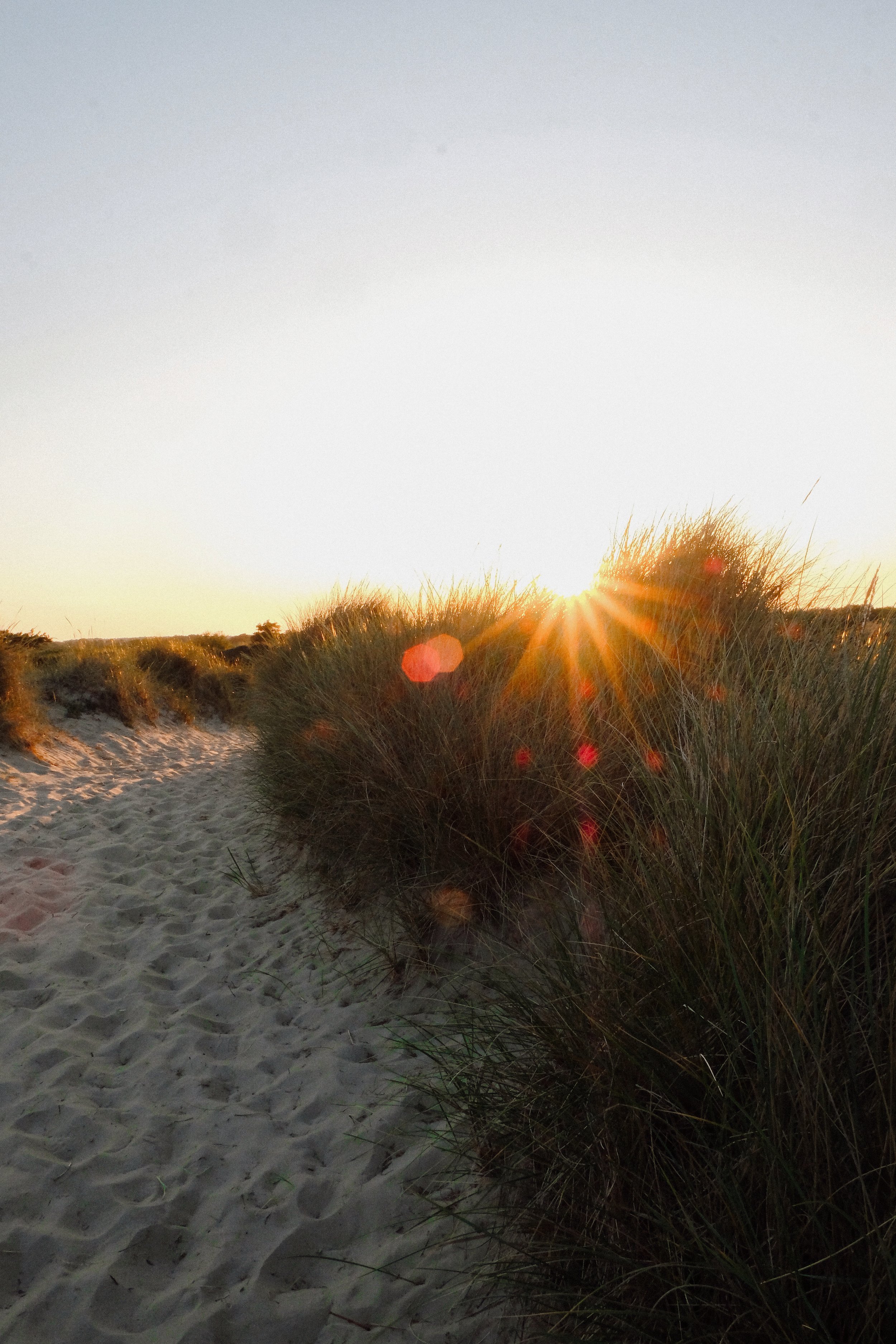Dorset Diaries: Part II
We pick up where we left off: the muddy field at the end of our coastal walk across Purbeck Way and Ballard Down. After ridding ourselves of mud splatter we headed back to Studland for dinner at The Pig. Having enjoyed it so much the first time we visited back in April, we could not wait to return.
We were early for our reservation, so enjoyed summer cocktails and pickled vegetables in a charming nook in their homely bar. Once seated, we enjoyed sourdough bread and focaccia with olive oil and sea salt, served on chintzy mismatched china, followed by crab salad and the adventurous choice of pigeon breast. With longer days, we were treated to uninterrupted views across Studland Bay for most of our meal. As darkness came, white candles emitted a radiant glow.
The following morning, we headed for brunch at The Cake House, an idyllic tearoom located on a working family farm in the hamlet of East Creech. They make homemade cakes, sandwiches, and other delicious treats onsite daily. In the June sun this rural spot becomes even more picturesque, especially as their resident animals flit around the place. Big white goose splash around in the pond and chickens dart between tables, helping tidy up and clean plates. After brunch, we said hello to their sheep, goats, donkeys, horses, turkeys and even rheas, who are kept in spacious paddocks behind the tearoom. We felt like we were walking through a children’s book, it was a special place.
Our afternoon was spent at Lulworth Castle and its imposing turrets, pleasing symmetry and imposing limestone façade is exactly what you envisage when you think of a quintessential castle. Lulworth Castle is an early-seventeen century hunting lodge erected in the style of a revival fortified castle, one of only five surviving Elizabethan or Jacobean buildings of this type. The eighteenth century neoclassical-style interior was devastated by fire in 1929 and while the exterior has been salvaged, the interior remains quite bare. Nevertheless, its grandiose history is clear to see, and you can learn all about it through detailed information panels and display cases.
In 1641 Humphrey Weld, grandson of a wealthy merchant from London and direct ancestor of the current owner, purchased the Lulworth Estate from Thomas Howard. The foundations of the castle were laid in 1588 and were completed between 1608 and 1610, supposedly designed by the first, most notable architect in England famous for introducing classical design to England’s building-scape: Inigo Jones. The English Civil War erupted not long after Weld’s ownership of the castle, and the estate was subsequently sequestrated by the Parliamentarians, who used it as a garrison. Regaining the property following the Civil War, Humphrey Weld remodelled the house into a liveable family home. It went through further iterations with subsequent owners, including Edward Weld in the early-eighteenth century, and Thomas Weld in the 1780s, who refurbished the interiors in the neoclassical-style of Scottish architect William Adam. John Tasker also built a Roman Catholic chapel – St Mary’s Chapel – in the grounds for Thomas Weld. He had to seek special permission from King George III and was granted authorisation to build the chapel on condition that it did not resemble a church from the outside. It was the first Roman Catholic chapel to be built in England since the Reformation. The castle also welcomed royalty. Thomas Weld entertained King George III and Queen Charlotte here in 1789 and, following the French Revolution, surviving members of the French royal family were invited to use Lulworth as one of their residences-in-exile. Charles X of France stayed at Lulworth briefly following the 1830 July Revolution.
We then climbed one of the castle’s towers and from the turret you are treated to the most magnificent views across the Purbeck Hills, out on to the sea beyond. You also get a good view of St Andrew’s Church, whose turret dates to the fifteenth-century, predating the laying of the castle’s foundations.
We spent our final evening at the tip of the Studland Peninsula. While it is only halfway through the year, we certainly found a contender for our favourite restaurant of the year: Shell Bay Seafood Bistro. We enjoyed the most incredible meal of soft shell crab and perfectly cooked sea bream fillets, paired with a glass of prosecco rosé. All this was enjoyed with a view of Stone Island Lake, Poole Harbour, Brownsea Island and the Studland to Sandbanks chain ferry taking passengers across the water. It was a wonderfully warm evening, and the setting sun was particularly special, turning the sky all shades of purple and making the water glitter.
It was golden hour as we left the restaurant, so we concluded our final evening with a walk along the beach. We began at Shell Bay Beach. We saw the charming sanderlings scurry back and forth as the waves ebbed and flowed, and watched the pink sky illuminate the white chalk cliffs of the Pinnacles, several miles in the distance. After several kilometres on the beach, we turned right into the sand dunes and heathland. The sun gilded the long grasses, fluttering in the gentle breeze. We took the path back to Ferry Road, crossing over to catch the final part of the sunset on Bramble Bush Bay Beach. It was the perfect summer evening; the light was dreamy, the temperature clement and the company even better!
Before Julie boarded a train back to London and Arran returned to work, we revisited The Goat in Wareham for our final breakfast, enjoying pains au chocolat and green smoothies by the river, already planning our next country escape which would be Somerset in a few weeks’ time.
Catch-up with Part I of our Dorset Diaries blogpost here.























